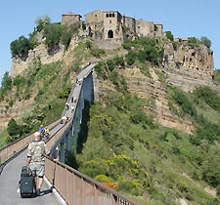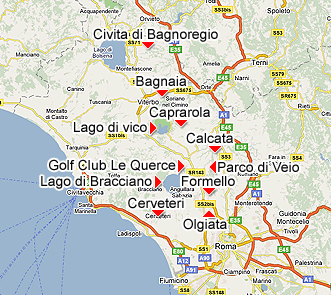Civita di Bagnoregio An
Italian hilltown An
Italian hilltownPeople who've been there say "Civita" (chee-VEE-tah) with warmth and love. This precious chip of Italy, a traffic-free community with a grow-it-in-the-valley economy, has so far escaped the ravages of modernity. Please approach it with the same respect and sensitivity you would a dying relative, because — in a sense — that's Civita. Civita teeters atop a pinnacle in a vast canyon ruled by wind and erosion. But, while its population has dropped to 14, the town survives (and even has a website: www.civitadibagnoregio.it). The saddle that once connected Civita to its bigger and busier sister town, Bagnoregio, eroded away. Today a bridge connects the two towns. A man with a Vespa does the same work his father did with a donkey — ferrying the town's goods up and down the umbilical bridge that connects Civita with a small, distant parking lot and the rest of Italy. Rome, just 60 miles to the south, is a world away. Entering the town through a cut in the rock made by Etruscans 2,500 years ago, and heading under a 12th-century Romanesque arch, you feel history in the huge, smooth cobblestones. This was once the main Etruscan road leading to the Tiber Valley and Rome. Inside the gate, the charms of Civita are subtle. Those looking for arcade tourism wouldn't know where to look. There are no lists of attractions, orientation tours, or museum hours. It's just Italy. Civita is an artist's dream, a town in the nude. Each lane and footpath holds a surprise. The warm stone walls glow, and each stairway is dessert to a sketch pad or camera. Sit in the piazza. Smile and nod at each local who passes by. It's a social jigsaw puzzle, and each person fits. The old woman hanging out in the window monitors gossip. A tiny hunchback lady is everyone's daughter. And cats, the fastest growing segment of the population, scratch their itches on ancient pillars. Civita's young people are gone, lured away by the dazzle of today to grab their place in Italy's cosmopolitan parade. And as old people become frail, they move into apartments in nearby Bagnoregio. Today, Civita's social pie has three slices: the aging, full-time residents; rich, big-city Italians who are slowly buying up the place for their country escape (a blue-blooded "Marchesa" owns the house next to the town gate — and Civita's first hot tub); and visitors enjoying la dolcezza di fare niente (the sweetness of doing nothing). Buoyed by my writing and exposure in German and French travel magazines, Civita can see up to 200 tourists a day on summer weekends. In summer, visit on a weekday. Explore the village. The basic grid street plan of the ancient town survives, but its centerpiece — a holy place of worship — rotates with the cultures: first an Etruscan temple, then a Roman temple, and today a church. The pillars that stand like bar stools in the square once decorated the pre-Christian temple. Step into the church. The heartbeat and pride of the village, this is where festivals and processions start, visitors are escorted, and the town's past is honored. Enjoy paintings by students of famous artists; relics of the hometown-boy Saint Bonaventure; a dried floral decoration spread across the floor; and a cool, quiet moment in a pew. The basic grid street plan of the ancient town survives. Just around the corner from the church, on the main street, is Rossana and Antonio's cool and friendly wine cellar (their sign reads bruschette con prodotti locali). Pull up a stump and let them or their children, Arianna and Antonella, serve you panini (sandwiches), bruschetta (garlic toast with optional tomato topping), wine, and a local cake called ciambella. Climb down into the cellar and note the traditional wine-making gear and the provisions for rolling huge kegs up the stairs. Tap on the kegs in the cool bottom level to see which are full (open April-Oct daily 11:00-17:00, Nov-March closed Thu). The ground below Civita is honeycombed with ancient cellars (for keeping wine at the same temperature all year) and cisterns (for collecting rainwater, since there was no well in town). Many of these date from Etruscan times. Explore further down the street, but remember — nothing is abandoned. Everything is still privately owned. After passing an ancient Roman tombstone on your left, you'll come to Vittoria's Antico Mulino, an atmospheric collection of old olive presses. The huge press in the entry is about 1,500 years old and was in use as recently as the 1960s (donation requested, give about €1). Antico Frantoio Bruschetteria is a rustic place for a bite to eat. Vittoria's sons, Sandro, Maurizio, and Felice, and her grandson Fabrizio (with his American wife, Heather) run the local equivalent of a lemonade stand, toasting delicious bruschetta (roughly 10:00–20:00 in summer, winter Sat–Sun only, tel. 0176-948-429). Peruse the menu, choose your topping (chopped tomato is super), and get a glass of wine for a fun, affordable snack. Farther down the way and to your left, Maria (for a donation of about €1) will show you through her garden with a grand view (Maria's Giardino) and share historical misinformation (she says Civita and Lubriano were once connected). Maria's husband, Peppone, used to carry goods on a donkey back and forth on the path between the old town and Bagnoregio. At the end of town, the main drag winds downhill past small Etruscan caves to your right. The first two were used as stables until a few years ago. The third cave is an unusual chapel, cut deep into the rock, with a barred door — this is the Chapel of the Incarcerated (Cappella del Carcere). In Etruscan times, the chapel may have originally been a tomb, and in medieval times, it was used as a jail. When Civita's few residents have a religious procession, they come here, in honor of the Madonna of the Incarcerated. After the chapel, the paving-stone path peters out into a dirt trail leading down and around to the right to a tunnel. Dating from the Etruscan era, the tunnel may have served as a shortcut to the river below. It was widened in the 1930s so farmers could get between their scattered fields more easily, and now the residents use it as a shortcut in fall to collect chestnuts from the trees that cover the hillside. Backtrack to the town square. At Trattoria Antico Forno ("The Antique Oven"), owner Franco serves up pasta at affordable prices (daily during peak season for lunch 12:30-15:30 and sporadically for dinner 19:30-22:00, on main square, also rents rooms, tel. 0761-760-016). Pina's Pizzeria cooks up good pizza and homemade sweets to eat there or to go (daily 12:00-22:00, near entry into town). Spend the evening. After dinner, sit on the church steps with people who've done exactly that for 60 years. Children play on the piazza until midnight. As you walk back to your car — that scourge of the modern world that enabled you to get here — stop under a lamp on the donkey path, listen to the canyon ...distant voices ...fortissimo crickets. Towering above its moat, Civita seems to be fortified against change. But the modern world is a persistent battering ram. Civita will be great for years, but never as great as today. |
